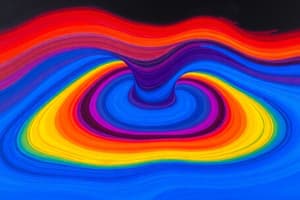Podcast
Questions and Answers
What characterizes plasmas in contrast to ordinary gases?
What characterizes plasmas in contrast to ordinary gases?
- They consist of ions and free electrons. (correct)
- They are always found under low pressure.
- They are composed only of neutral atoms.
- They cannot exist at high temperatures.
Which method is NOT commonly used to convert a gas into plasma?
Which method is NOT commonly used to convert a gas into plasma?
- Using lasers with high intensity.
- Applying high voltage.
- Exposing to high temperatures.
- Cooling the gas rapidly. (correct)
At what temperature does helium form a Bose-Einstein condensate?
At what temperature does helium form a Bose-Einstein condensate?
- At absolute zero (0 K).
- Below -273.15°C. (correct)
- Above -270.98°C.
- At any temperature as long as it is under pressure.
What is a key factor in the formation of a Bose-Einstein condensate?
What is a key factor in the formation of a Bose-Einstein condensate?
What is a defining characteristic of neutron stars?
What is a defining characteristic of neutron stars?
What defines matter in chemistry?
What defines matter in chemistry?
Which type of bond is characterized by the sharing of electron pairs?
Which type of bond is characterized by the sharing of electron pairs?
What is the primary difference between real gases and ideal gases?
What is the primary difference between real gases and ideal gases?
Which factor does not affect the rate of chemical reactions?
Which factor does not affect the rate of chemical reactions?
Which of the following best describes a reversible reaction?
Which of the following best describes a reversible reaction?
Flashcards are hidden until you start studying
Study Notes
States of Matter
- Matter is anything that has mass and volume.
- It can exist in different states such as solid, liquid, gas, and plasma.
- Plasma is a high-energy state of matter where atoms lose electrons and form ions.
- Bose-Einstein Condensate (BEC) is a state of matter at extremely low temperatures, near absolute zero.
- Neutron stars are the densest form of matter in the universe, formed from the collapse of massive stars.
Properties and Measurements
- Properties are classified as chemical or physical.
- Chemical properties change the substance's chemical identity, while physical properties do not.
- Extensive properties depend on the amount of matter, while intensive properties do not.
Temperature Measurement
- Temperature is a measure of how hot or cold an object is.
- It is measured using thermometers and can be expressed in different scales like Celsius, Kelvin, and Fahrenheit.
- Kelvin is the SI unit of temperature.
- Absolute zero (0 K) is the theoretical point at which all particle motion stops.
Electromagnetic Radiation
- Electromagnetic radiation (EM) is composed of electric and magnetic components.
- Light is an example of electromagnetic radiation.
- Light behaves as both waves and particles (photons), possessing both wave and particle properties.
- Light waves travel at the highest known velocity of 300,000 kilometers per second.
Light Wave Characteristics
- Wavelength (λ): Distance between two consecutive crests or troughs of a wave.
- Amplitude: Vertical distance between the midline and the peak or trough of a wave.
- Frequency (ν): Number of waves passing a point per second, measured in Hertz (Hz).
- Wavenumber (ν̄): Number of waves per centimeter, expressed in cm⁻¹.
Relationships Between Wavelength, Frequency, and Wavenumber
- The relationship between wavelength, frequency, and wavenumber is given by the equation: c = λν, where c is the speed of light in a vacuum.
- The energy (E) of a photon is directly proportional to its frequency and inversely proportional to its wavelength.
- This relationship is described by the equation: E = hν = hc/λ, where h is Planck's constant (6.625 × 10⁻³⁴ J·s).
Studying That Suits You
Use AI to generate personalized quizzes and flashcards to suit your learning preferences.




